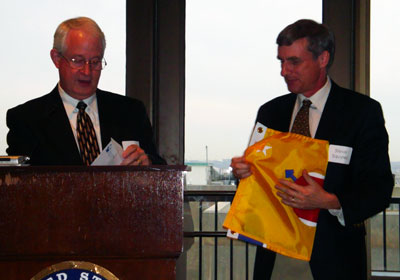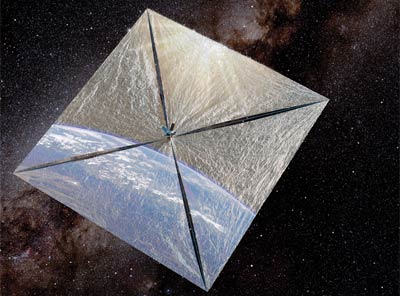Solar sailing gets its second windby Jeff Foust
|
| The biggest drawback of solar sails is that no one has successfully flown one yet, although not for lack of effort. |
Nearly four and a half years after that failure, though, The Planetary Society is gearing up to make another attempt. At a Washington, DC, event November 9, the society announced plans for a new solar sail effort, called LightSail. The three-spacecraft program, supported by a million-dollar anonymous donation, is designed to demonstrate the ability to use solar sail technology to maneuver spacecraft in Earth orbit and beyond.
“We are going to merge the ultra-light technology of nanosats with the ultra-large technology of solar sails in an audacious new program,” said Lou Friedman, executive director of The Planetary Society.
A key difference between LightSail and Cosmos 1 is that the new mission leverages advancements in smallsat technology. Cosmos 1, built by Lavotchkin Association in Russia, weighed a modest 100 kilograms. LightSail-1, the first of the three planned spacecraft, will be far smaller: less than five kilograms. The spacecraft will make use of CubeSat technology, nanosatellites measuring only 10 centimeters on a side. LightSail-1 will consist of three CubeSats: one serving as the central electronics and control module, and the other two containing the solar sail.
LightSail-1, currently under development by a small California company, Stellar Exploration, will be ready for launch in late 2010. No specific launch vehicle has been identified, although Friedman said they are looking at several options, both in the US and Russia. The spacecraft is compatible with the “P-POD” CubeSat deployment system that has been used to launch CubeSats on several different rockets. The exact choice of launch vehicle will depend on what is available when the spacecraft is ready, with a preference for one that can put LightSail-1 into a high enough initial orbit—around 800 kilometers—where atmospheric drag does not counteract the sail’s thrust.
One option has been ruled out, though. “We’re not going to fly on a submarine-launched ballistic missile,” Friedman said, referring to the Volna. “That’s one lesson learned” from the Cosmos 1 program.
The mission of LightSail-1 will be modest: deploy its sail, made of 32 square meters of Mylar, and demonstrate the ability of that sail to change the spacecraft’s orbit. If successful, LightSail-2 will fly into higher Earth orbits, while LightSail-3 will go to the Earth-Sun L-1 point, 1.5 million kilometers away. No dates have been set for those two missions; Friedman said their timing depend on the success of the first mission.
The Planetary Society sees one near-term application of small solar sail spacecraft in monitoring of solar activity, including solar storms, from the L-1 point. The LightSail spacecraft themselves aren’t intended to be space science missions but instead technology pathfinders for future missions that could use sails to carry instruments to the L-1 point.
| “Throughout Carl’s life, and the efforts of The Planetary Society, we’re trying to do things that are culturally significant,” Tyson said. |
The society also played up a long-term use of these spacecraft: as interstellar voyagers, using lasers in lieu of the Sun to provide the light needed to send them beyond the solar system. “Sailing on light is a pathway to the stars, but on that path are also some very important scientific and engineering applications that help us understand and protect our own planet and explore other worlds,” Planetary Society president Jim Bell said in a statement about the project.
 Wes Huntress (left) gives the Thomas O. Paine Award for the Advancement of Human Exploration of Mars to Steve Squyres for leading the Mars rover missions. (credit: J. Foust) |
The announcement took place on the 75th anniversary of the birth of Carl Sagan, one of the co-founders of The Planetary Society. His widow, Ann Druyan, is supporting this project as she did Cosmos 1, and Friedman credited her with that continued support during the years after the failure of that earlier effort. “Even when I was tempted to give up hope, she became a light of optimism—or should I say, a ray of sunshine.”
The LightSail announcement was just one part of the Washington event, which was more broadly about Sagan and his legacy. Society vice president Bill Nye and board member Neil deGrasse Tyson recounted their experiences with Sagan and the role he played in getting the public interested in the universe.
“Throughout Carl’s life, and the efforts of The Planetary Society, we’re trying to do things that are culturally significant,” Tyson said. “Which is actually not that hard, given the good material we’ve got to work with: the universe is good material to draw from.”
The event also featured the presentation of the Thomas O. Paine Award for the Advancement of Human Exploration of Mars to Steve Squyres, principal investigator of the Mars Exploration Rovers, Spirit and Opportunity. Squyres accepted the award on behalf of what he called an “astonishing and passionate team of engineers and scientists” whose efforts have allowed the rovers to operate on Mars far longer than anyone anticipated.
But the theme of the event was building upon Sagan’s legacy, with the LightSail project as one small step in that effort. “The people Carl Sagan worked with and loved are blazing a trail to the stars in his honor,” said former vice president Al Gore in a video shown at the Washington event. “There could be no greater birthday gift for the Carl Sagan that I knew.”
